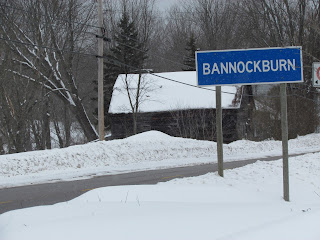The beaches of Lake Ontario in Prince Edward county have long been a summer playground. Incredible natural beauty, a rare topography, fresh air and healthy outdoor recreation, family picnics and holidays...and amour. Two baymouth sandbars, across the entrances of West and East Lake (once called Sandbanks and Outlet beaches, respectively, a great deal easier to explain than today's provincially amalgamated Sandbanks Provincial Park.

Photos of well-dressed ladies perched on the sand-dunes in buttontop boots, high collared white blouses and wide hats never fail to amuse. On excursions, or resident at respectable resorts like Lakeshore Lodge, they enjoyed (somewhat formally) the area in late 1800's and early c.20.
 |
| once the road to the dunes, now a protected panne |
Photos from the 1930's, 40's and 50's show an increasing number of less formally attired folk enjoying sand and waves. Because there were no roads, auto traffic accessed the Outlet Beach (as folk who grew up around here called it) by driving between the dunes and out onto the hard-packed sand. Towels tucked in car windows provided change rooms, nature provided other amenities.

In 1957, the provincial goverment took over the beach we locals called the Outlet, and land along the Outlet River leading from East Lake to Lake Ontario (where until now most of the picnicking, dancing, and tower-diving occurred at a privately run resort - most recently known as Martin's). They built a road inshore of the dunes at that beach - today's park road.
 |
| overlooking West Lake |
The story can be found in this post on my heritage architecture (and themes related) blog.
 |
| mouth of the Outlet River, firmly closed |
But our interest settles on the beaches of the 1940's, when a feckless, pre-Eurithe Al Purdy did what all the boys did...took girls to the beach. A local guy with the extra appeal of an RCAF uniform, and an old if unreliable Whippet or Ford for transportation, Al squired the occasional local girl to the beach, for the same reasons fellows have made those pilgrimages forever...the healthy outdoor recreation, of course.
Here are Al's accounts of two such hopeful adventures. He did not emerge the stuff of romantic fiction in either case. His candour about his ineptitude is charming.
"Shirley and I drove to the sand banks near Picton a couple of days later, with the ostensible purpose of swimming. I ran the car out of gas along the way and had to walk to a service station for more, at considerable loss of dignity....For the first time in my slightly retarded life I was on the verge of contact with another mind and body...And I blew it."
"Shirley and I drove to the sand banks near Picton a couple of days later, with the ostensible purpose of swimming. I ran the car out of gas along the way and had to walk to a service station for more, at considerable loss of dignity....For the first time in my slightly retarded life I was on the verge of contact with another mind and body...And I blew it."
 |
| the beach the way I like it |
And on another occasion, with another date:
"We went swimming later at the sand banks near Picton (scene of my earlier embarrassment with Shirley).I continued my seduction attempts very seriously. Same result, no dice.
In the bright moonlight, parked on the romantic sandy shore of Lake Ontario. Acting Sergeant A. Purdy: "Dear (whatever-the-hell-her-name-was), Let's drive farther down the beach where it's quiet (read, darker).Okay?" "Okay".
The Ford wouldn't move. Migawd, what's happening? Wheels are spinning around in the wet sand. I give it the gun, they spin some more. We were mired in the sand, permanently, or at least an hour of permanence. I had parked the car where the small and harmless waves made sleepy soothing noises which I thought might be romantically helpful.
Someone in another moonlit vehicle knew the girl, so I ditched her with them. Then called a farmer with tractor for hire nearby to haul me out of the sand. When I paid for the service, my girl was long gone... "
Embarrassing. Cringe-making. Most of us can identify with Al's candid seduction-gone-terribly-wrong stories. Next time you're on "the Outlet beach", elbow to elbow with sun-bathers, think back to those days when folks drove out and parked there, in the moonlight. Hearts full of love...and hope.
(excerpts from Reaching from the Beaufort Sea, pages 84,88)
(archival shot courtesy Prince Edward County Library and Archives)





.JPG)
.JPG)
.JPG)



.JPG)
.JPG)
.JPG)
.JPG)
.JPG)
.JPG)


















.JPG)
.JPG)
.JPG)
.JPG)